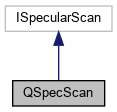Scan type with z-components of scattering vector as coordinate values. More...
 Inheritance diagram for QSpecScan:
Inheritance diagram for QSpecScan:Public Member Functions | |
| QSpecScan (const IAxis &qs_nm) | |
| QSpecScan (int nbins, double qz_min, double qz_max) | |
| Sets q-defined specular scan. More... | |
| QSpecScan (std::vector< double > qs_nm) | |
| Accepts qz-value vector (in inverse nm) | |
| QSpecScan * | clone () const override |
| double | offset () const |
| const ScanResolution * | resolution () const |
| void | setAbsoluteQResolution (const IRangedDistribution &distr, const std::vector< double > &std_dev) |
| Sets qz resolution values via IRangedDistribution and values of standard deviations. More... | |
| void | setAbsoluteQResolution (const IRangedDistribution &distr, double std_dev) |
| void | setOffset (double offset) |
| void | setQResolution (const ScanResolution &resolution) |
| Sets q resolution values via ScanResolution object. | |
| void | setRelativeQResolution (const IRangedDistribution &distr, const std::vector< double > &rel_dev) |
| Sets qz resolution values via IRangedDistribution and values of relative deviations (that is, rel_dev equals standard deviation divided by the mean value). More... | |
| void | setRelativeQResolution (const IRangedDistribution &distr, double rel_dev) |
Detailed Description
Scan type with z-components of scattering vector as coordinate values.
Wavelength and incident angles are not accessible separately.
Constructor & Destructor Documentation
◆ QSpecScan()
| QSpecScan::QSpecScan | ( | int | nbins, |
| double | qz_min, | ||
| double | qz_max | ||
| ) |
Sets q-defined specular scan.
Accepts either numpy array of q-values sorted in ascending order or an IAxis object with q-values. Alternatively an axis can be defined in-place, then the first passed parameter is the number of bins, second - minimum on-axis q-value, third - maximum on-axis q_value.
Member Function Documentation
◆ setAbsoluteQResolution()
| void QSpecScan::setAbsoluteQResolution | ( | const IRangedDistribution & | distr, |
| const std::vector< double > & | std_dev | ||
| ) |
Sets qz resolution values via IRangedDistribution and values of standard deviations.
std_dev can be either single-valued or a numpy array. In the latter case the length of the array should coinside with the length of the qz-axis.
◆ setRelativeQResolution()
| void QSpecScan::setRelativeQResolution | ( | const IRangedDistribution & | distr, |
| const std::vector< double > & | rel_dev | ||
| ) |
Sets qz resolution values via IRangedDistribution and values of relative deviations (that is, rel_dev equals standard deviation divided by the mean value).
rel_dev can be either single-valued or a numpy array. In the latter case the length of the array should coinside with the length of the qz-axis.
